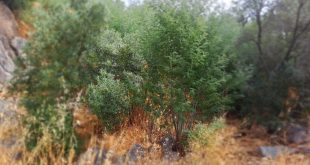How we can become a part of the water cycle, using water without using it up.
- Only plant a variety of indigenous tree and bush species together;
- Fit gutters and build water tanks to collect the water from roofs;
- Only farm organically; don’t use any agro-chemicals in the garden, instead use goat or horse dung;
- Don’t seal off any areas in the garden or farm (e.g. with concrete) or cover them with plastic sheeting. The rainwater must be able to seep into the ground;
- Break up monocultures in the garden too, at least with hedges, or leave a corner of the garden untouched with wild plants;
- Bare earth hardens in the sun and frost, and allows no water to seep into the ground: it should have plants on it, or be mulched with organic material;
- Always construct paths, flowerbeds and rows of plants on contour lines;
- Never build paths, roads or houses in the bottom of a valley or on the banks of a river;
- Where the land slopes, build terraces, as far as possible sloping slightly inwards;
- Do not channel rainwater away from a plot but into the plant beds;
- Having a bath rather than a shower reduces water consumption considerably;
- Keep the water from washing dishes and clothes and use it for watering. Only use biodegradable products;
- Equip toilets with water-saving devices or replace them completely with compost toilets or tree bogs;
- The important thing is what gets into the wastewater (drains, toilets): so, no cleaning materials or oil/fats, or microplastics. These are plastic particles that are smaller than five mm. in size and are hidden by industry in shampoos, shower gels, toothpaste, liquid soaps, face peels, sun creams etc;
- When it’s hot, never water during the day, but in the morning or the evening! Even if the leaves of plants are drooping: watering during the day does more harm than good;
- Choose plants and seeds that are appropriate for the region; reduce the amount of lawn or turn it into a vegetable garden;
- For plants that require lots of water, choose suitable corners of the garden – shady, near a pond, ditch etc.
- Use aquaponics: cultivate vegetables and salads in a bowl of water; this saves water and fertiliser;
- Experimente a aquaponia: legumes criados em tanques poupam água e adubo;
- One final tip for sportspeople. Don’t buy any more disposable PET water bottles. Use water bottles that you can refill from a tap or fountain. You can find them in well-known sports shops in half-litre, one-litre and 1.5-litre sizes.
 Eco123 Revista da Economia e Ecologia
Eco123 Revista da Economia e Ecologia

